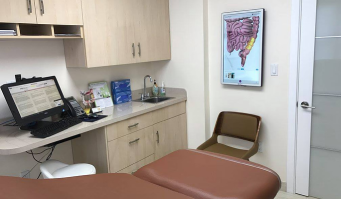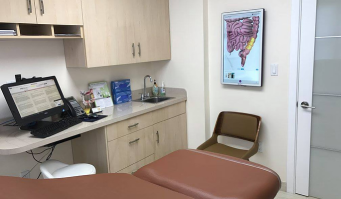Barrett’s Esophagus
- Over 1000 5 Star Reviews
- Personalized Care
- Award Winning GI Specialist
What is Barrett’s esophagus?
Barrett’s esophagus is a serious condition that develops when the lining of your lower esophagus is damaged by prolonged exposure to stomach acid. This damage can lead to changes in the cells, which in rare cases can develop into esophageal cancer.
While primarily affecting individuals with long-term gastroesophageal reflux disease (GERD), only a small percentage of GERD sufferers develop Barrett’s esophagus. Discussing your risk and potential need for screening with a gastroenterologist is crucial.
A diagnosis of Barrett’s esophagus raises concerns due to its increased risk of cancer progression. As it is a premalignant condition for esophageal adenocarcinoma, regular monitoring and early intervention are essential. In some cases, precancerous tissue, known as dysplasia, may develop. Fortunately, this dysplasia can be treated before becoming cancerous.
Therefore, if you have Barrett’s esophagus, more frequent cancer screenings are necessary. Consult your gastroenterologist to develop a comprehensive treatment plan and discuss appropriate screening options.
CAUSES OF Barrett’s Esophagus
The exact cause of Barrett’s esophagus remains a medical mystery. While a strong association exists with long-standing GERD, a significant portion of individuals with Barrett’s esophagus experience no reflux symptoms, a phenomenon termed “silent reflux.”
Regardless of symptom presence, the backwash of stomach acid and chemicals into the esophagus damages its sensitive tissues, triggering changes in the lining of this vital swallowing tube. This ultimately leads to the development of Barrett’s esophagus.
Symptoms of Barrett’s Esophagus
- Frequent heartburn and regurgitation of stomach contents
- Difficulty swallowing food
- Less commonly, chest pain
Diagnosis of Barrett’s Esophagus
An upper endoscopy is the primary tool used to diagnose Barrett’s esophagus. This minimally invasive procedure involves passing a thin, flexible tube with a camera (endoscope) down your throat to visualize the lining of your esophagus. During the endoscopy, your doctor can assess the appearance of the esophageal tissue. Normal tissue appears pale and glossy, while Barrett’s esophagus presents with a red and velvety appearance. Additionally, your doctor may collect tissue samples (biopsies) during the endoscopy to confirm the diagnosis and assess the degree of cellular changes.
Treatment of Barrett’s Esophagus
Treatment for Barrett’s esophagus is individualized and depends on the severity of abnormal cell growth and your overall health.
No dysplasia:
- Regular monitoring:
- GERD management:
Low-grade dysplasia:
- Verification:
- Close monitoring:
- Treatment: Due to the cancer risk, treatment may be initiated if the diagnosis is confirmed. Preferred options include:
- Endoscopic resection:
- Radiofrequency ablation:
- Cryotherapy:
- Additional treatment:
High-grade dysplasia:
High-grade dysplasia carries a high risk of progressing to esophageal cancer. Therefore, your doctor will likely recommend prompt treatment with endoscopic resection, radiofrequency ablation, or cryotherapy. Alternatively, surgery may be considered, where the damaged portion of your esophagus is removed and reconnected to your stomach.
Recurrence of Barrett’s esophagus is possible even after treatment. Discuss with your doctor the frequency of necessary follow-up testing to monitor for potential recurrence. If your treatment does not involve surgical removal of the abnormal tissue, you will likely be prescribed lifelong medication to reduce stomach acid and aid in esophageal healing.

“Thank you for visiting Forest Hills Gastroenterology & Liver Disease, my goal is to treat my patients in a highly personalized manner and I am dedicated to give you the utmost attention and respect that you deserve. For more infromation on this disease or to schedule a consultation with me, please give us a call or book a tele-health appointment online.”
Albert Shalomov
Dr. Albert Shalomov, MD
Disclaimer: Educational Infromation, Not Medical Advice
It’s important to remember that the information provided here is intended for educational purposes only and should not be misconstrued as definitive medical advice. Always seek the guidance of a qualified gastroenterologist for accurate diagnosis and treatment of any specific gastrointestinal condition. Only trained healthcare professionals can provide personalized recommendations and ensure your well-being.




